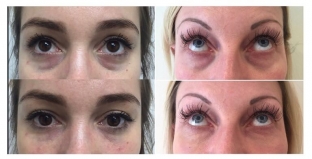As you know, the skin around the eyes is particularly delicate – it is up to 10 times thinner than the skin on other parts of the face. At the same time, patients often turn to an esthetician specifically for the rejuvenation of the periorbital region, in particular, to eliminate dark circles under the eyes, which give the face a tired look and visually age the face. However, as practitioners note, correction of the periorbital zone is one of the most difficult and leaves little room for error. In this article, estet-portal.com gives the opinions of experts on the choice of procedures that are most effective in correcting dark circles under the eyes, as well as their recommendations for minimizing side effects.
Correction of dark circles under the eyes: mechanisms of the problem
There are a number of reasons why dark circles can appear under the eyes. However, plastic surgeon Kambiz Golchin identifies two main causes of this problem:
- Skin hyperpigmentation.
- Anatomical features: very thin skin, insufficient subcutaneous tissue, resulting in visible vessels.
In youth, the border between the lower eyelid and the cheek is smooth, but with aging, soft tissues are destroyed, the natural volumes in this area are lost, as a result of which the bone structures become more visible.
Oculoplasty surgeon Sabrina Shah-Desai explains how anatomical changes cause dark circles in the periorbital region:
“By the age of 30, patients begin to develop subtle dark circles under the eyes. This is due to the loss of subcutaneous fat in the tissues of the eyelid, thinning and hyperpigmentation of the skin. By the age of 35-40, changes in bone tissues appear; the eye socket begins to expand, and the middle part of the face is deformed. The maxillary bone, which is responsible for the projection of the front of the cheek, begins to lose its volume. Such changes lead to more pronounced dark circles and the appearance of bags under the eyes.

Fig. 1 Before and after the correction of dark circles under the eyes with HA fillers by injection into the lacrimal trough. Photo: Natali Kelly As far as hyperpigmentation around the eyes is concerned, this problem is significantly influenced by the ethnicity of the patient: people with darker skin types are generally predisposed to the appearance of periorbital hyperpigmentation. Dr. Natali Kelly explains: “I often see patients with dark Fitzpatrick skin types. In such cases, it is very difficult to carry out procedures and you have to wait longer for the results to appear. At the same time, the doctor needs not only to correct dark circles under the eyes, but also to solve the problem with complexion in general, which is significantly affected by solar exposure. Practitioners recommend taking extra care when working with darker skin types.
Dermatologist Jane Ranneva (Jane Ranneva) from Spain claims that the majority of her patients who complain of periorbital hyperpigmentation are Fitzpatrick type IV & VI skin types, as their skin reacts more actively to any irritation.Dr. Kelly explains that patients with hyperpigmentation around the eyes often require a combination of treatments.
Dark circles under the eyes can be a reflection of the lifestyle of the patient: improper diet, lack of water in the body, diseases, chronic lack of sleep and the habit of rubbing the eyes can provoke this problem even in 20 years.
Dr. Golchin explains that the only way to get good results when correcting dark circles under the eyes – collect the most detailed patient history in order to make a correct diagnosis and determine the exact cause of the problem.Correction of dark circles under the eyes: preliminary consultation
For example, in case of hyperpigmentation, peels, creams or laser treatments should be used. If the main reason for the appearance of dark circles under the eyes – blood vessels and thinning of the skin, good results can be obtained with injection techniques.
The only way to get good results when correcting dark circles under the eyes – collect the most detailed patient history in order to make a correct diagnosis and determine the exact cause of the problem.
Fig. 2 Before and after the introduction of HA-based fillers into the lacrimal trough
BoostEye
 . Photo: Dr. Sabrina Shah-Desai
. Photo: Dr. Sabrina Shah-Desai
Hyaluronic acid for dark circles under the eyes Effective correction of dark circles under the eyes is possible by tear trough volumization, and this option is most often chosen by practitioners. Dr. Ranneva calls the introduction of non-cross-linked HA into this area a masking procedure. In case of hyperpigmentation, the volumizing product allows light to be reflected off the face, thus avoiding the appearance of a shadow in the periorbital area. Dr. Ranneva uses the RRS HA Eyes filler, which, in addition to increasing volume, also stimulates lymphatic drainage. The doctor injects 0.65 ml of the product deep and superficially around each eye.
Dr. Kelly also uses HA fillers in his practice:"Most of the time, we're volumizing with a light-reflecting HA-based dermal filler that reduces the appearance of dark circles. I use a small amount of material – no more than half a syringe on each side of the face. As a rule, the tear trough is quite deep due to the loss of volume in the cheek area, especially in thin patients whose face does not contain enough fat, therefore this procedure is mainly aimed at volumizing the cheeks."If you provide support around the cheekbone and eye, the skin is pulled tight and a small amount of medication needs to be injected directly into the tear trough."
Dr. Shah-Desai uses his own officially registered technique when injecting HA into the lacrimal trough – Eye Boost:
"I use a very light filler that provides hydration to the skin and does not create visible bumps. I introduce the product deeply and superficially. Most patients need this technique to get a natural result. Between the medial angle of the eye and the medial limbus of the eye, which is determined by the anatomy of the ligament in the area of the tear trough, I superficially inject a very small amount of moisturizing filler. In the central and lateral parts of the sulcus, I use a cohesive filler, laying it on the periosteum, under the ligament that holds the orbicular muscle of the eye.
It is important to remember that even when corrected by a qualified and experienced physician, complications can occur, so every practitioner should be prepared for them.
Possible complications when correcting dark circles under the eyes with HA-based fillers:
bruises;
swelling;Tyndall effect;
swelling;
- tubercle formation;
- tissue necrosis;
- blindness.
- Fortunately, according to Dr. Golchin, most of the side effects can be eliminated. To do this, hyaluronidase – is injected into the problem area. the enzyme will begin to work immediately, and the complete resolution of complications will take 2-3 days.
- Platelet-Rich Plasma to correct dark circles under the eyes
- Another effective way to correct dark circles under the eyes is to use stem cells for skin regeneration, which are injected with platelet-rich plasma (PRP).
Dr. Kelly uses PRP in combination with
mesotherapy and notes the high effectiveness of this technique:
Dr. Kelly applies platelet-rich plasma to the skin around the eyes: approximately 1 ml under the eyes or 5 ml on the entire face, and then performs mesotherapy with a pen, which creates micro-damages in the skin, stimulates collagen production and promotes skin tightening. The device works fractionally, so that small amounts of PRP penetrate the skin. As a rule, 0.5 mm – the maximum size of the needle that the doctor uses to treat the area around the eyes.
The choice of PRP and mesotherapy is often due to a lower risk of bruising and swelling, as well as a shorter recovery period, compared to filler injections. Dr. Kelly often recommends a course of treatments to his patients 4 to 6 weeks apart.
Dr. Golchin's clinic also uses PRP to work on the tear trough. The doctor uses highly concentrated platelet-rich plasma and injects it using a cannula technique at two different levels – directly under the skin and a little deeper. This improves the vascularization of the area and the structures surrounding the blood vessels in order to increase collagen synthesis.
Maximum results appear after 3-6 months. As a rule, Dr. Golchin performs 2 procedures with an interval of 3 months.
When using PRP, it is very important to evaluate the patient's health status to ensure the positive results of the procedure. Healthy eating and the absence of bad habits – important factors to be taken into account.
The only complication after PRP, according to Dr. Golchin, is bruising. To avoid such a complication, it is necessary to introduce the material carefully and accurately.Adipose tissue grafting to correct dark circles under the eyes
The use of fat is another way to influence the area of the lacrimal trough with stem cells. Transplantation of adipose tissue – surgical procedure. However, as Dr. Golchin notes, the stem cells in the patient's own fat regenerate the skin, improve its quality and allow you to correct dark circles under the eyes in the long term – this is the main advantage of this method.
The sampling of adipose tissue, which is injected into the periorbital region, is most often carried out from the abdomen or thighs. Despite the fact that the correction of the area around the eyes is carried out using a small amount of fat, patients have the opportunity, for example, to get rid of extra centimeters on the abdomen in one procedure.
Dr. Golchin also notes that the correct technique for
lipofillingis extremely important, as too aggressive exposure or improper processing of fat can subsequently lead to lumpiness in the area being corrected. Despite the technical difficulties of this procedure, it provides simply amazing results.
There are various ways to effectively correct dark circles under the eyes. For best results, a careful examination of the patient and determination of the underlying cause of dark circles is essential. The risk of complications in the delicate area around the eyes should not be underestimated even by professionals with extensive experience. The doctor must be sure to warn his patients of potential complications and be prepared to resolve them.







Add a comment